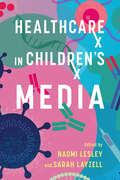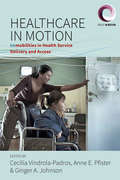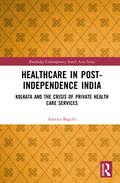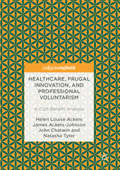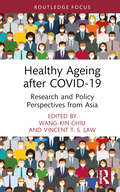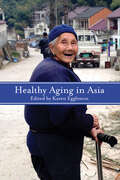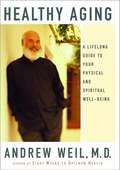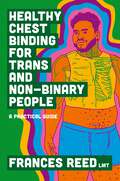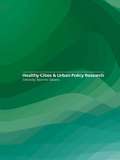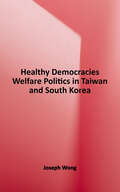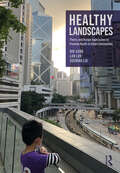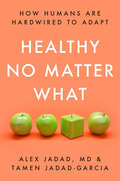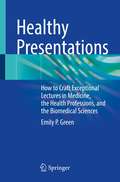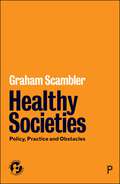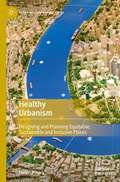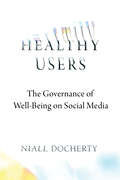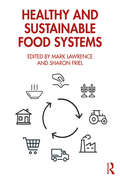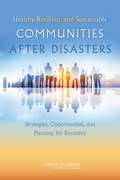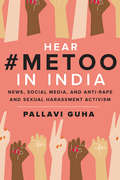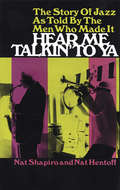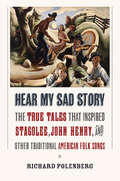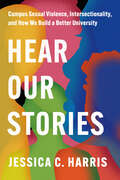- Table View
- List View
Healthcare in Children's Media (Children's Literature Association Series)
by Naomi Lesley Sarah LayzellContributions by Anna Bugajska, Dayna Campbell, Dallas Ducar, Sudeshna Shome Ghosh, Melanie Goss, Joseph Holloway, Jeremy Johnston, Manjushri Karthikeyan, Jenise Katalina, Sarah Layzell, Naomi Lesley, Anna Macdonald, Vanessa E. Martínez-Renuncio, Nichole Mayweather-Banks, Madison Miner, Dawn Sardella-Ayres, Farriba Schulz, Carrie Spencer, Antje Tannen, Valerie A. Ubbes, and B.J. Woodstein Healthcare in Children’s Media, edited by Naomi Lesley and Sarah Layzell, is a collection of essays and interviews from scholars, activists, and practitioners grappling with crucial questions about representations of healthcare systems, both formal and informal, in children’s media. The volume focuses on systems of healthcare rather than individual narratives of illness. It examines how children are socialized into knowledge about healthcare. Essays explore critiques of existing systems embedded in children's literature, analyze how children’s books might be used for health literacy education, and examine children’s film and television for visions of alternative systems and solutions to ethical dilemmas. Contributors in Healthcare in Children’s Media draw upon interdisciplinary approaches including disability studies, gender studies, public health, bibliotherapy, and posthumanism. Essays examine care systems in the US, the UK, Germany, India, and Iran, and also offer a breadth of historical perspective ranging from the turn of the twentieth century through our present times and into projections of future bioethical and posthuman dilemmas. This volume adds fresh works to archives of health literacy books, with analytic perspectives on race and disability that medical writers might not consider.
Healthcare in Motion: Immobilities in Health Service Delivery and Access (Worlds in Motion #5)
by Cecilia Vindrola-Padros Ginger A. Johnson Anne E. PfisterHow does the need to obtain and deliver health services engender particular (im)mobility forms? And how is mobility experienced and imagined when it is required for healthcare access or delivery? Guided by these questions, Healthcare in Motion explores the dynamic interrelationship between mobility and healthcare, drawing on case studies from across the world and shedding light on the day-to-day practices of patients and professionals.
Healthcare in Post-Independence India: Kolkata and the Crisis of Private Healthcare Services (Routledge Contemporary South Asia Series)
by Amrita BagchiThis book analyses the development of private healthcare in post-Independence Kolkata, India, and the rapid expansion of private nursing homes and hospitals from a historical and sociological perspective. It offers an examination of the changing pattern of the entire health care sector, which over recent decades has transformed itself to a profit-making commodity. The book explores the complexities of the health care services in Kolkata with special emphasis on the emergence, growth, role and the changing pattern of private health care organisations and the decline or degeneration of the services of public hospitals. Post-1947 India experienced the implementation of new developments in public health services, amongst others vertical programmes, primary health centers, family planning welfare programmes and community health volunteers. Examining the challenges in establishing a comprehensive health service system and the process of market forces in health care, the author investigates its linkages with policies of the welfare state. This book will be of interest to academics in the field of medical sociology, history of medicine and health and development studies and South Asian Studies.
Healthcare, Frugal Innovation, and Professional Voluntarism
by Helen Louise Ackers James Ackers-Johnson John Chatwin Natasha TylerThis book is open access under a CC BY 4. 0 license. This book investigates what international placements of healthcare employees in low resource settings add to the UK workforce and the efficacy of its national health system. The authors present empirical data collected from a volunteer deployment project in Uganda focused on reducing maternal and new-born mortality and discuss the learning and experiential outcomes for UK health care professionals acting as long term volunteers in low resource settings. They also develop a model for structured placement that offers optimal learning and experiential outcomes and minimizes risk, while shedding new light on the role that international placements play as part of continuing professional development both in the UK and in other sending countries.
Healthy Ageing after COVID-19: Research and Policy Perspectives from Asia (ISSN)
by Wang-Kin Chiu and Vincent T. S. LawWritten by researchers and experienced health professionals from Hong Kong, China, Chiu and Law identify and examine important issues of healthy ageing after COVID-19 from research and policy perspectives in the Asian contexts.This book opens with discussions of healthy ageing from personal, social, economic, and political perspectives. These discussions make reference to the key characteristics of a community health model. It aims to examine the impacts of the COVID-19 pandemic on aged care in an international perspective, citing the fifth wave of COVID-19 in Hong Kong as a case report. Comprehensive analysis on the influence of COVID-19 infection on Hong Kong and the implemented anti-pandemic policy measures, as well as recommendations of post-pandemic policies to promote healthy ageing, are provided. This monograph also reviews the worldwide impacts on aged care during and after the pandemic, as well as the experience of aged care services in Hong Kong and other Asia-Pacific regions. The responding changes in policies and strategies for healthy ageing in selected countries are also reviewed. This monograph ends with a highlight on the design and development of a community model for healthy ageing, providing insights to the achievement of sustainable healthy ageing with reference to the sustainable development goal (SDG) 3.A valuable resource to governments, politicians, academics, and practitioners, it is intended for formulating future directions of relevant research, and the design and implementation of interventions for the promotion of healthy ageing in the post-pandemic era.
Healthy Aging in Asia
by Karen EgglestonLife expectancy in Japan, South Korea, and much of urban China has now outpaced that of the United States and other high-income countries. With this triumph of longevity, however, comes a rise in the burden of noncommunicable diseases (NCDs) like diabetes and hypertension, reducing healthy life years for individuals in these aging populations, as well as challenging the healthcare systems they rely on for appropriate care. The challenges and disparities are even more pressing in low- and middle-income economies, such as rural China and India. Moreover, the COVID-19 pandemic has underscored the vulnerability to newly emerging pathogens of older adults suffering from NCDs, and the importance of building long-term, resilient health systems. What strategies have been tried to prevent NCDs—the primary cause of morbidity and mortality — as well as to screen for early detection, raise the quality of care, improve medication adherence, reduce unnecessary hospitalizations and increase "value for money" in health spending? Fourteen concise chapters cover multiple aspects of policy initiatives for healthy aging and economic research on chronic disease control in diverse health systems — from cities such as Singapore and Hong Kong to large economies such as Japan, India, and China.
Healthy Aging in Sociocultural Context: Healthy Aging In Sociocultural Context (Routledge Advances in Sociology #81)
by Andrew E. Scharlach Kazumi HoshinoHealthy Aging in Sociocultural Context examines two emerging trends facing countries throughout the world: population aging and population diversity. It makes a unique contribution to our understanding of these timely issues by examining their implications for healthy aging, a topic of increasing importance to policy-makers, planners, researchers, families, and individuals of all ages. The book focuses on three countries that provide important examples of these emerging global trends - Japan, Sweden, and the United States. Japan and Sweden are at the forefront in terms of healthy life expectancies, while the United States represents a country with considerable diversity. Examining these three countries together provides a unique opportunity to address questions such as the following: How can we understand differences in healthy life expectancy among different countries? What role might diversity play? And how might these effects change as geographic mobility increases diversity, even among societies that historically have been relatively homogeneous?
Healthy Aging: A Lifelong Guide to Your Physical and Spiritual Well-Being
by Andrew WeilAndrew Weil M.D. offers information on nutrition, diet and exercise to promote graceful and healthy aging.
Healthy Chest Binding for Trans and Non-Binary People: A Practical Guide
by Frances ReedBinding is a crucial strategy in many transgender and non-binary people's lives for coping with gender dysphoria, yet the vast majority of those who bind report some negative physical symptoms. Written by Frances Reed, a licensed bodywork and massage therapist specialising in gender transition, this comprehensive guide helps you make the healthiest choices from the very start of your binding journey.Including guidance for choosing the right binder, approaching your first bind, an overview of potential health risks and complications, a range of self-massage and self-fascial release exercises to minimize pain and dysphoria, as well as tips and tricks for exercising safely in a binder - this is the ultimate resource for anyone that practices chest binding.
Healthy Cities and Urban Policy Research
by Takehito TakanoHealthy Cites and Urban Policy Research is a collection of papers by leading experts from academia or international organisations who have been involved in the Healthy Cities Movement. It is the first academic work to combine public health with urban planning. Contemporary issues from various perspectives are included which address evaluation, evidence-based practice, accountability, community participation and information technology.
Healthy Democracies: Welfare Politics in Taiwan and South Korea
by Joseph WongDo the pressures of economic globalization undermine the welfare state? Contrary to the expectations of many analysts, Taiwan and South Korea have embarked on a new trajectory, toward a strengthened welfare state and universal inclusion. In Healthy Democracies, Joseph Wong offers a political explanation for health care reform in these two countries. He focuses specifically on the ways in which democratic change in Taiwan and South Korea altered the incentives and ultimately the decisions of policymakers and social policy activists in contemporary health care debates. Wong uses extensive field research and interviews to explore both similarities and subtle differences in the processes of political change and healthcare reform in Taiwan and South Korea. During the period of authoritarian rule, he argues, state leaders in both places could politically afford to pursue selective social policies--reform was piecemeal and health care policy outcomes far from universal. Wong finds that the introduction of democratic reform changed the political logic of social policy reform: vote-seeking politicians needed to promote popular policies, and health care reform advocates, from bureaucrats to grassroots activists, adapted to this new political context. In Wong's view, the politics of democratic transition in Taiwan and South Korea has served as an effective antidote to the presumed economic imperatives of social welfare retrenchment during the process of globalization.
Healthy Landscapes: Theory and Design Approaches to Promote Health in Urban Communities
by Bin Jiang Lan Luo Xueming LiuThis book responds to the need for a comprehensive and detailed theoretical framework and systemic design approaches to improve mental, physical, social, behavioral, and ecological health in urban environments.Although rapid urban development has created enormous economic and social value, it has also brought problems that have posed serious threats to the health of urban residents. Healthy Landscapes begins by reviewing practical experience, as well as theoretical and scientific evidence, from several related disciplines around the world. This is used to construct a provisional framework consisting of ten theoretical pathways for the environment to promote mental, physical,social, behavioral, and ecological health: Relieving mental stress; restoring direct attention; promoting environmental preference; promoting sublime and transcendent perceptions; promoting active lifestyles; preventing the spread of infectious diseases; promoting ecological services; enhancing social support; promoting the sense of belonging; and improving the sense of security. From these 24 theoretical pathways, the authors go on to identify 67 critical environmental characteristics for creating healthy communities, which are used to inform the design guidelines they go on to apply to community environment scenarios.This book will be an invaluable resource for students of landscape architectural design, architecture, and urban design. It will also be an essential tool for design professionals and urban administrators who want a comprehensive understanding of the fundamental theories of healthy communities with design guidelines supported by scientific evidence.
Healthy Minds in the Twentieth Century: In and Beyond the Asylum (Mental Health in Historical Perspective)
by Steven J. Taylor Alice BrumbyThis open access edited collection contributes a new dimension to the study of mental health and psychiatry in the twentieth century. It takes the present literature beyond the ‘asylum and after’ paradigm to explore the multitude of spaces that have been permeated by concerns about mental well-being and illness. The chapters in this volume consciously attempt to break down institutional walls and consider mental health through the lenses of institutions, policy, nomenclature, art, lived experience, and popular culture. The book adopts an international scope covering the historical experiences of Britain, Ireland, and North America. In accordance with this broad approach, contributions to the volume span academic fields such as history, arts, literary studies, sociology, and psychology, mirroring the diversity of the subject matter. This book is available open access under a CC BY 4.0 license at link.springer.com
Healthy No Matter What: How Humans Are Hardwired to Adapt
by Alex Jadad Tamen Jadad-GarciaA provocative manifesto that teaches you how to take control of your own health, no matter your age or circumstances—from an innovative doctor and his philosopher daughter&“If you care about your health or the well-being of others, read this book.&”—Ethan Kross, author of ChatterDr. Alex Jadad is the creator of the Jadad scale, which has become the world&’s most widely used methodology to assess the quality of clinical trials, and his daughter Tamen Jadad-Garcia is a health entrepreneur and philosopher. Here they combine their expertise to uncover the medical system&’s unstable foundations, which condemn you to be ill. The Jadads begin this exploration with a simple question: &“What is health?&”Through engaging stories and case studies, the Jadads expand the understanding of health beyond the medical industrial complex. They show how distant connections in your personal networks can influence key aspects of yourself, like your weight, anxiety, and addictions; how reliance on medications can be reduced by intentionally designing the places where you live, work, and play; and how comparisons with peers can shorten your life.In this practical guide, the meaning of health is redefined, putting you in the driver&’s seat and recognizing you as the most effective evaluator. Building on data and experiences from millions of people around the world, the book reveals that a healthy life is possible even with complex chronic conditions or terminal illnesses. The Jadads explain why perceiving yourself as unhealthy might actually be fatal, and how you can monitor your true health and boost it in practically any context, no matter your cultural background or socioeconomic circumstances.With wisdom and empathy, Healthy No Matter What teaches you how your natural gift of adaptability equips you to overcome any obstacle, provides actionable pointers, and shows how and when to use the medical system, so that you can thrive, regardless of the twists and turns life may take.
Healthy Presentations: How to Craft Exceptional Lectures in Medicine, the Health Professions, and the Biomedical Sciences
by Emily P. GreenThis book is a practical guide for busy clinicians and educators within the biomedical sciences on how to improve their presentations. It includes specific, practical guidance on crafting a talk, tips on incorporating interactive elements to facilitate active learning, and before-and-after examples of improved slide design. Chapters discuss all aspects of exceptional presentations such as the identification of main concepts, organization of content, and best practices for creating lectures that are focused on the facilitation of learning rather than on passive information transfer. The examples provided are grounded in the biomedical sciences where presentations are necessarily dense and rich with critical content, making this book an essential read for anyone who lectures within a biomedical curriculum or presents at professional conferences. This book also addresses hot topics in medical education such as presenting on virtual platforms, and reviewing teaching materials for diversity, inclusion, and bias. These topics are not addressed in any other books on the market, and they address real gaps in medical and health professions training. Written from the perspective of an educator with over 20 years of experience in medical education, Healthy Presentations: How to Craft Exceptional Lectures in Medicine, the Health Professions, and the Biomedical Sciences recognizes the importance of high-quality, inclusive, and learner-centered presentations, and it provides essential guidance and support to the faculty who create them.
Healthy Societies: Policy, Practice and Obstacles (21st Century Standpoints)
by Graham ScamblerCan society be healthy, and how? Is Britain a ‘healthy society’ in the 21st century? When people ponder health, they usually consider the health of the individual, but individuals co-exist in a social environment so attention should be placed on the health of communities and populations. Re-examining health, healthcare and societal health using the latest data and research, this book provides a clear, accessible account of the current state of play. Addressing definitions of health in individuals, communities and populations, definitions of society itself, changes in health over time and the contribution of healthcare to health and longevity, it also suggests ways of effectively tackling obstacles to improving health and healthcare in 21st century Britain.
Healthy Urbanism: Designing and Planning Equitable, Sustainable and Inclusive Places (Planning, Environment, Cities)
by Helen PineoThe globally distributed health impacts of environmental degradation and widening inequalities require a fundamental shift in understandings of healthy urbanism. This book redefines the meaning and form of healthy urban environments, urging planners and design professionals to consider how their work impacts population health and wellbeing at multiple spatial and temporal scales. The concepts of equity, inclusion and sustainability are central to this framing, reversing the traditional focus on individuals, their genes and ‘lifestyle choices’ to one of structural factors that affect health. Integrating theory and concepts from social epidemiology, sustainable development and systems thinking with practical case studies, this book will be of value for students and practitioners.
Healthy Users: The Governance of Well-Being on Social Media
by Niall DochertyWe are often told that social media well-being is simply the result of individual users making healthy digital choices. All it takes is a little self-discipline. In this book, Niall Docherty looks closely at this belief and exposes the complex relations of power expressed through its articulation and enactment. Docherty creatively and empirically shows how the discourses, designs, and habits of online well-being push user conduct in certain directions, at the expense of others. This is a contingent mode of governance that combines logics of neoliberalism, practices of psychologized person-making, and persuasive capitalist interfaces. By highlighting the damaging effects of this current arrangement, Healthy Users charts a path that will change how we understand and study social media well-being in the future.
Healthy and Sustainable Food Systems
by Mark Lawrence Sharon FrielThis comprehensive text provides the latest research on key concepts, principles and practices for promoting healthy and sustainable food systems. There are increasing concerns about the impact of food systems on environmental sustainability and, in turn, the impact of environmental sustainability on the capacity of food systems to protect food and nutrition security into the future. The contributors to this book are leading researchers in the causes of and solutions to these challenges. As international experts in their fields, they provide in-depth analyses of the issues and evidence-informed recommendations for future policies and practices. Starting with an overview of ideas about health, sustainability and equity in relation to food systems, Healthy and Sustainable Food Systems examines what constitutes a food system, with chapters on production, manufacturing, distribution and retail, among others. The text explores health and sustainable diets, looking at issues such as overconsumption and waste. The book ends with discussions about the politics, policy, personal behaviours and advocacy behind creating healthy and sustainable food systems. With a food systems approach to health and sustainability identified as a priority area for public health, this text introduces core knowledge for students, academics, practitioners and policy-makers from a range of disciplines including food and nutrition sciences, dietetics, public health, public policy, medicine, health science and environmental science.
Healthy, Resilient, and Sustainable Communities After Disasters: Strategies, Opportunities, and Planning for Recovery
by Medical Social Services Committee on Post-Disaster Recovery of a Community’s Public HealthIn the devastation that follows a major disaster, there is a need for multiple sectors to unite and devote new resources to support the rebuilding of infrastructure, the provision of health and social services, the restoration of care delivery systems, and other critical recovery needs. In some cases, billions of dollars from public, private and charitable sources are invested to help communities recover. National rhetoric often characterizes these efforts as a "return to normal. " But for many American communities, pre-disaster conditions are far from optimal. Large segments of the U. S. population suffer from preventable health problems, experience inequitable access to services, and rely on overburdened health systems. A return to pre-event conditions in such cases may be short-sighted given the high costs - both economic and social - of poor health. Instead, it is important to understand that the disaster recovery process offers a series of unique and valuable opportunities to improve on the status quo. Capitalizing on these opportunities can advance the long-term health, resilience, and sustainability of communities - thereby better preparing them for future challenges. "Healthy, Resilient, and Sustainable Communities After Disasters" identifies and recommends recovery practices and novel programs most likely to impact overall community public health and contribute to resiliency for future incidents. This book makes the case that disaster recovery should be guided by a healthy community vision, where health considerations are integrated into all aspects of recovery planning before and after a disaster, and funding streams are leveraged in a coordinated manner and applied to health improvement priorities in order to meet human recovery needs and create healthy built and natural environments. The conceptual framework presented in "Healthy, Resilient, and Sustainable Communities After Disasters" lays the groundwork to achieve this goal and provides operational guidance for multiple sectors involved in community planning and disaster recovery. "Healthy, Resilient, and Sustainable Communities After Disasters" calls for actions at multiple levels to facilitate recovery strategies that optimize community health. With a shared healthy community vision, strategic planning that prioritizes health, and coordinated implementation, disaster recovery can result in a communities that are healthier, more livable places for current and future generations to grow and thrive - communities that are better prepared for future adversities.
Hear #metoo in India: News, Social Media, and Anti-Rape and Sexual Harassment Activism
by Pallavi GuhaThis book examines the role media platforms play in anti-rape and sexual harassment activism in India. Including 75 interviews with feminist activists and journalists working across India, it proposes a framework of agenda-building and establishes a theoretical framework to examine media coverage of issues in the digitally emerging Global South.
Hear Me Talkin' to Ya
by Nat Hentoff Nat Shapiro"Music is your own experience, your thoughts, your wisdom. If you don't live it, it won't come out of your horn." -- Charlie Parker"What is jazz? The rhythm -- the feeling." -- Coleman Hawkins"The best sound usually comes the first time you do something. If it's spontaneous, it's going to be rough, not clean, but it's going to have the spirit which is the essence of jazz." -- Dave BrubeckHere, in their own words, such famous jazz musicians as Louis Armstrong, King Oliver, Fletcher Henderson, Bunk Johnson, Duke Ellington, Fats Waller, Clarence Williams, Jo Jones, Jelly Roll Morton, Mezz Mezzrow, Billie Holiday, and many others recall the birth, growth, and changes in jazz over the years. From its beginnings at the turn of the twentieth century in the red-light district in New Orleans (or Storyville, as it came to be known), to Chicago's Downtown section and the Original Dixieland Jazz Band and Chicago's South Side to jam sessions in Kansas City to Harlem during the Depression years, the West Coast and modern developments, the story of jazz is vividly and colorfully documented in hundreds of personal interviews, letters, tape recorded and telephone conversations, and excerpts from previously printed articles that appeared in books and magazines.There is no more fascinating and lively history of jazz than this firsthand telling by the men who made it. It should be read and re-read by all jazz enthusiasts, musicians, students of music and culture, students of American history, and other readers. "A lively book bearing the stamp of honesty and naturalness." -- Library Journal. "A work of considerable substance." -- The New Yorker. "Some of the quotations are a bit racy but they give the book a wonderful flavor." -- San Francisco Chronicle.
Hear My Sad Story: The True Tales That Inspired "Stagolee," "John Henry," and Other Traditional American Folk Songs
by Richard PolenbergIn 2015, Bob Dylan said, "I learned lyrics and how to write them from listening to folk songs. And I played them, and I met other people that played them, back when nobody was doing it. Sang nothing but these folk songs, and they gave me the code for everything that's fair game, that everything belongs to everyone." In Hear My Sad Story, Richard Polenberg describes the historical events that led to the writing of many famous American folk songs that served as touchstones for generations of American musicians, lyricists, and folklorists.Those events, which took place from the early nineteenth to the mid-twentieth centuries, often involved tragic occurrences: murders, sometimes resulting from love affairs gone wrong; desperate acts borne out of poverty and unbearable working conditions; and calamities such as railroad crashes, shipwrecks, and natural disasters. All of Polenberg's account of the songs in the book are grounded in historical fact and illuminate the social history of the times. Reading these tales of sorrow, misfortune, and regret puts us in touch with the dark but terribly familiar side of American history.On Christmas 1895 in St. Louis, an African American man named Lee Shelton, whose nickname was "Stack Lee," shot and killed William Lyons in a dispute over seventy-five cents and a hat. Shelton was sent to prison until 1911, committed another murder upon his release, and died in a prison hospital in 1912. Even during his lifetime, songs were being written about Shelton, and eventually 450 versions of his story would be recorded. As the song--you may know Shelton as Stagolee or Stagger Lee--was shared and adapted, the emotions of the time were preserved, but the fact that the songs described real people, real lives, often fell by the wayside. Polenberg returns us to the men and women who, in song, became legends. The lyrics serve as valuable historical sources, providing important information about what had happened, why, and what it all meant. More important, they reflect the character of American life and the pathos elicited by the musical memory of these common and troubled lives.
Hear No Evil: Politics, Science & the Forensic Evidence in the Kennedy Assassination
by Jim Lesar Donald Byron ThomasDid a shot from the "grassy knoll" kill President Kennedy? If so, was Oswald part of a conspiracy or an innocent patsy? Why have scientific experts who examined the evidence failed to put such questions to rest? In 2001, scientist Dr. Donald Byron Thomas published a peer-reviewed article that revived the debate over the finding by the House Select Committee on Assassinations that there had indeed been a shot from the grassy knoll, caught on a police dictabelt recording. The Washington Post said, "The House Assassinations Committee may well have been right after all."In Hear No Evil, Thomas explains the acoustics evidence in detail, placing it in the context of an analysis of all the scientific evidence in the Kennedy assassination. Revering no sacred cows, he demolishes myths promulgated by both Warren Commission adherents and conspiracy advocates, and presents a novel and compelling reinterpretation of the "single bullet theory." More than a scientific tome, Hear No Evil is a searing indictment of the government's handpicked experts, who failed the public trust to be fair and impartial arbiters of the evidence.
Hear Our Stories: Campus Sexual Violence, Intersectionality, and How We Build a Better University
by Jessica C. HarrisDespite focused efforts to stop the perpetration of campus sexual violence, the statistic that one in four college women will experience such violence has remained steady over the last sixty years. The number of higher education institutions under federal Title IX investigation for mishandling sexual violence cases also continues to grow. In Hear Our Stories, Jessica Harris demonstrates how preventive efforts often fall short because they lack intersectional perspectives, and often obscure how sexual violence is imbued with racial significance. Drawing on interviews with Women of Color student survivors, staff, and documents from three different universities, this book analyzes sexual violence on the college campus from an intersectional lens, centering the stories of Women of Color. Harris explores the intersectional realities of campus sexual violence, including survivors' racialized and gendered experiences with campus rape culture, institutional betrayal, prevention programming, reporting and disclosing, and feminist and anti-racist movements. Hear Our Stories challenges dominant approaches to campus sexual violence that too-often stall the implementation of more effective sexual violence prevention and response efforts that could offer transformative outcomes for all students.
